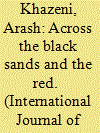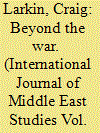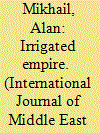|
|
|
Sort Order |
|
|
|
Items / Page
|
|
|
|
|
|
|
| Srl | Item |
| 1 |
ID:
101168


|
|
|
|
|
| Publication |
2010.
|
| Summary/Abstract |
Through a reading of 19th-century Persian travel narratives, this article locates the history of Iran and Central Eurasia within recent literature on global frontier processes and the encounter between empire and nature. It argues that Persianate travel books about Central Eurasia were part of the imperial project to order and reclaim the natural world and were forged through the material encounter with the steppes. Far from a passive act of collecting information and more than merely an extension of the observer's preconceptions, description was essential to the expansion and preservation of empire. Although there exists a vast literature on Western geographical and ethnographic representations of the Middle East, only recently have scholars begun to mine contacts that took place outside of a Western colonial framework and within an Asian setting. Based on an analysis of Riza Quli Khan Hidayat's Sifaratnama-yi Khvarazm, the record of an expedition sent from the Qajar Dynasty to the Oxus River in 1851, the article explores the 19th-century Muslim "discovery" of the Eurasian steppe world. The expedition set out to define imperial boundaries and to reclaim the desert, but along the way it found a permeable "middle ground" between empires, marked by transfrontier and cross-cultural exchanges.
|
|
|
|
|
|
|
|
|
|
|
|
|
|
|
|
| 2 |
ID:
101169


|
|
|
|
|
| Publication |
2010.
|
| Summary/Abstract |
This article seeks to address how Lebanese youth are dealing with the legacy of civil war (1975-90), given the national backdrop of official silence, persisting injustice, and competing memory discourses. Drawing on Marianne Hirsch's concept of postmemory, it explores the memory of a generation of Lebanese who have grown up dominated not by traumatic events but by narrative accounts of events that preceded their birth. This residual form of memory carries and connects with the pain of others, suffusing temporal frames and liminal positions. The article examines how postmemory is mediated and transformed through the mnemonic lenses of visual landscapes and oral narratives. Consideration is given to the dynamic production of "memoryscapes"-memories of violence localized in particular sites-and to narrative constructions of the past implicated in the ongoing search for meaning, historical truth, and identity. This article seeks to challenge pervasive notions of Lebanese postwar amnesia and of a generational detachment from the residual effects and future implications of war recollections.
|
|
|
|
|
|
|
|
|
|
|
|
|
|
|
|
| 3 |
ID:
101167


|
|
|
|
|
| Publication |
2010.
|
| Summary/Abstract |
Using both Ottoman Turkish and Arabic archival materials, this article narrates the history of irrigation in Fayyum during the first half of the 18th century. Its environmental perspective shows how a shared reliance on natural resource management bound together extremely rural regions of the Ottoman Empire like Fayyum with centers of power in Istanbul and Cairo. It seeks to make two historiographical interventions. First, its focus on irrigation reveals how the center-periphery model of early modern empires fails to capture the complexity of relationships that rural regions of the Ottoman Empire maintained with other provinces and towns both in the empire and beyond. Water in Fayyum grew food that forged connections of commodity movement with areas of the Mediterranean and Red Seas. Second, through an examination of such intraimperial and transregional ties, this article argues that Egyptian peasants held much of the power in these relationships.
|
|
|
|
|
|
|
|
|
|
|
|
|
|
|
|
| 4 |
ID:
101166


|
|
|
|
|
| Publication |
2010.
|
| Summary/Abstract |
Drawing on a range of recent studies and original sources, this article calls for a revision of the usual paradigm of disease in Ottoman history by applying a more interdisciplinary approach and new insights from environmental history. The historiography of disease in the Middle East developed from the late 1970s to the early 1990s envisioned a steady mortality from inevitable cycles of bubonic plague supposedly accepted with pious resignation by Ottoman Muslims. Focusing on the period from circa 1500 to 1800, the article advances three arguments. First, Ottoman Muslims sometimes did take action to escape or contain epidemics. Second, the region actually suffered from a variety of other infections that together had an equal or greater impact than bubonic plague. Third, shifting political, social, and environmental conditions-especially Little Ice Age climate fluctuations and population movements during the 17th century-played a major role in disease mortality and Ottoman demography.
|
|
|
|
|
|
|
|
|
|
|
|
|
|
|
|
| 5 |
ID:
101170


|
|
|
|
|
| Publication |
2010.
|
| Summary/Abstract |
The purpose of this article is twofold. First, we aim to evaluate the records of executive branches of the Lebanese government that are involved in public social spending in terms of their ability to respond to need. Second, we attempt to uncover the criteria underlying the distribution of public social spending. The allocation of funds across sectors and administrative districts is evaluated according to a vector of the socioeconomic characteristics of each locality thought to be of relevance. We find that the association between need and spending is, at best, very loose. When we use the geographical distribution of spending and voting data from each locality to estimate each religious sect's share of public spending, we find a striking conformity between the sectarian composition of the population and each sect's estimated share of national public spending. The logic of the disbursement of public funds and the mechanism underlying the observed one-man one-dollar distribution rule-a rule with primacy over health, education, and infrastructure needs as well as imbalances across regions-is that distribution be balanced across sects.
|
|
|
|
|
|
|
|
|
|
|
|
|
|
|
|
|
|
|
|
|